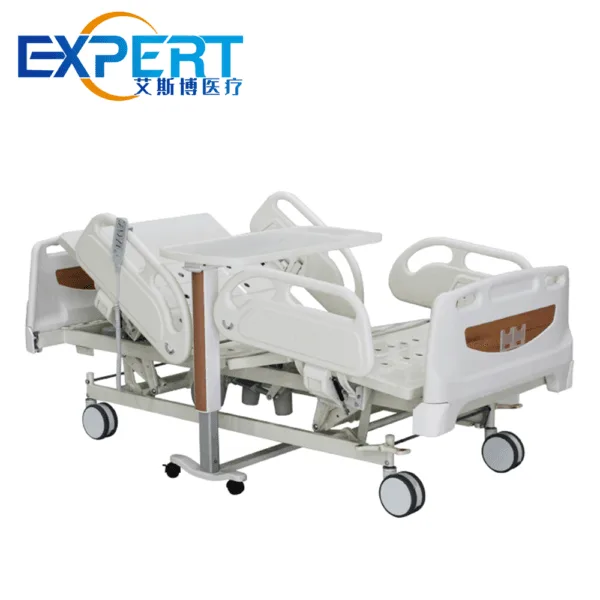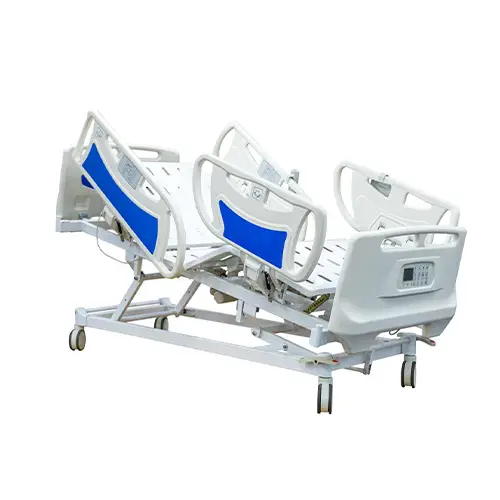Dirección
304 North Cardinal St.
Dorchester Center, MA 02124
Horas laborales
Lunes a viernes: 7:00 a. M. - 7:00 p. M.
Fin de semana: 10 a. M. - 5 p. M.
¡Bienvenido a mi blog!
Antes de profundizar en el contenido, si está interesado en nuestros productos o tiene alguna pregunta, no dude en visitar nuestra Contáctenos Página del sitio web. Nuestro equipo está listo para atenderle con consultas, pedidos o cualquier asistencia que necesite.
Ahora, comencemos nuestro viaje juntos. Espero que el contenido aquí les resulte interesante, interesante y valioso.

En lo que respecta a la atención domiciliaria, elegir la longitud adecuada de una cama de hospital es crucial tanto para la comodidad del paciente como para la del cuidador. Ya sea que el paciente se esté recuperando de una cirugía, lidiando con una enfermedad crónica o necesite asistencia adicional, la cama debe adaptarse a sus necesidades físicas sin crear dificultades innecesarias.
Este blog le guiará a través de los diversos aspectos de la selección de la longitud adecuada de una cama de hospital, los factores que influyen en su elección y cómo esta decisión afecta el bienestar general del paciente. Al comprender la importancia de elegir la longitud correcta de una cama de hospital, podrá tomar una decisión informada que le brinde comodidad y practicidad para la atención domiciliaria.
La longitud estándar de una cama de hospital suele ser de unas 80 pulgadas (203 cm o 1,90 m). Esta longitud se adapta cómodamente a la mayoría de los adultos, ofreciendo suficiente espacio de movimiento y asegurando un soporte completo. Sin embargo, dependiendo de la altura y las necesidades de movilidad del paciente, podría requerirse una longitud de cama diferente.
Algunas camas de hospital vienen con longitudes extendidas, que a menudo alcanzan los 213 cm o más. Estas camas extendidas son ideales para pacientes altos que necesitan espacio adicional para estirarse sin sentirse apretados. Por otro lado, también existen opciones de camas más cortas, generalmente de unos 190 cm, para pacientes de complexión más pequeña o que prefieren un espacio más compacto. Conocer la variedad de longitudes disponibles le permitirá elegir la que mejor se adapte a las necesidades del paciente.
| Longitud de la cama de hospital | Adecuado para | Soporte de altura promedio |
|---|---|---|
| 75 pulgadas | Pacientes más pequeños o de menor estatura | Hasta 5 pies 8 pulgadas |
| 80 pulgadas | Longitud estándar para la mayoría de los adultos. | Hasta 6 pies de altura |
| 84 pulgadas | Personas más altas que requieren más espacio | Más de 6 pies de altura |
Elegir la longitud adecuada de una cama de hospital garantiza que el paciente tenga un soporte completo y pueda descansar cómodamente. Las camas demasiado cortas o demasiado largas pueden causar incomodidad o dificultad de movilidad, lo que puede derivar en complicaciones de salud adicionales. En un entorno de atención domiciliaria, donde el espacio y la comodidad son prioritarios, la longitud de la cama es fundamental para promover un ambiente tranquilo, seguro y propicio para la recuperación.









El factor más importante para determinar la longitud adecuada de una cama de hospital es la altura del paciente. Las personas más altas necesitarán más espacio para descansar cómodamente, lo cual se puede lograr optando por camas de mayor longitud. De igual manera, los pacientes con problemas de movilidad pueden necesitar espacio adicional para moverse, sentarse o ajustar su posición sin sentirse limitados por el marco de la cama.
Para los pacientes que necesitan ayuda para moverse o trasladarse de la cama, una cama de hospital más larga ofrece mayor flexibilidad. Además, puede evitar que los pies del paciente sobresalgan del borde, lo que puede causar problemas de circulación o molestias.
Las dimensiones de la habitación también influyen significativamente en la selección de la longitud de una cama de hospital para atención domiciliaria. Una cama más larga requiere más espacio, lo que puede limitar el movimiento en la habitación tanto del paciente como de los cuidadores. Si el espacio es limitado, una cama de hospital de longitud estándar o más corta puede ser una opción más práctica, ya que garantiza suficiente espacio para el equipo médico, los cuidadores y facilita el movimiento.
Antes de comprar una cama de hospital, mida el espacio disponible para asegurarse de que la longitud elegida encaje cómodamente sin sobrecargar la habitación.
Las camas de hospital cuentan con diferentes tipos de ajuste, como elevación de cabecero y pies, y la posibilidad de extender o acortar la longitud de la cama. Para los pacientes que requieren ajustes regulares de postura, elegir una cama con longitud ajustable ofrece mayor flexibilidad.
Algunas camas permiten modificar su longitud para adaptarse a diferentes situaciones, lo que proporciona versatilidad ante necesidades cambiantes. En estos casos, los cuidadores pueden extender la cama cuando sea necesario o acortarla para ahorrar espacio cuando no se necesite.
Además de la altura y el espacio, es fundamental considerar las necesidades médicas generales del paciente y su comodidad. Si un paciente presenta afecciones como hinchazón en las piernas o requiere cambios frecuentes de postura, una cama más larga proporcionará el espacio necesario para almohadas adicionales o dispositivos terapéuticos.
Además, elegir la longitud adecuada garantiza que los pacientes puedan mantener una buena postura y evitar la tensión muscular, lo que es especialmente importante para los cuidados a largo plazo.


Para los cuidadores, la longitud adecuada de una cama de hospital puede marcar una diferencia significativa en las tareas diarias, como el reposicionamiento o el traslado del paciente. Si la cama es demasiado corta, el paciente puede deslizarse hacia abajo o sentirse constreñido, lo que dificulta que el cuidador lo mueva con seguridad. Por el contrario, si la cama es demasiado larga, puede crear dificultades innecesarias para acceder al paciente o realizar las tareas relacionadas con el cuidado.
Una cama de hospital de tamaño adecuado ayuda a reducir la tensión de los cuidadores, especialmente durante los traslados o al ajustar la posición del paciente. Las camas con la longitud adecuada reducen la necesidad de levantar objetos o alcanzarlos de forma incómoda, minimizando así el riesgo de lesiones tanto para el paciente como para el cuidador. Una longitud adecuada también facilita al cuidador el uso de dispositivos de apoyo como grúas, barandillas o ayudas para la movilidad.
En definitiva, la longitud correcta de una cama de hospital puede tener un profundo impacto en el bienestar del paciente. Una cama demasiado pequeña o demasiado grande puede causar incomodidad, lo que puede agravar afecciones médicas o dificultar la recuperación. Al elegir la longitud correcta, puede garantizar que el paciente se mantenga cómodo y con apoyo, lo que promueve un mejor sueño, una mejor recuperación y una experiencia de atención domiciliaria más positiva en general.

| Longitud de la cama de hospital | Ventajas | Contras |
|---|---|---|
| 75 pulgadas | Compacto; ideal para espacios más pequeños. | Puede ser demasiado corto para personas más altas. |
| 80 pulgadas | Tamaño estándar; se adapta a la mayoría de los pacientes. | Es posible que no se acomoden pacientes más altos |
| 84 pulgadas | Proporciona espacio adicional para personas más altas. | Requiere más espacio y puede saturar los espacios. |
Seleccionar lo correcto longitud de una cama de hospital Es fundamental para crear un entorno de atención domiciliaria cómodo y eficiente. La altura, la movilidad, el tamaño de la habitación y las necesidades médicas del paciente influyen en la determinación de la longitud de cama más adecuada. Las camas de longitud estándar son adecuadas para la mayoría de las personas, pero los pacientes más altos pueden beneficiarse de camas de longitud extendida para garantizar su comodidad y seguridad. Los cuidadores también se benefician de una longitud de cama adecuada, ya que mejora el acceso y reduce la tensión al brindar cuidados.
Elegir la longitud correcta de la cama de hospital no solo mejora la comodidad del paciente, sino que también garantiza una mejor experiencia de atención general, lo que hace que sea más fácil para el paciente y el cuidador gestionar las tareas diarias y mantener una mejor calidad de vida.
¿Cuál es la longitud estándar de un Cama de hospital?
La longitud estándar de una cama de hospital suele ser de 80 pulgadas, pero hay otras opciones disponibles, como camas más cortas de 75 pulgadas o camas extendidas de 84 pulgadas para personas más altas.
¿Cómo elijo la longitud adecuada de una Cama de hospital ¿Para el cuidado domiciliario?
Para elegir la longitud adecuada, tenga en cuenta la altura del paciente, sus necesidades de movilidad y el espacio disponible en la habitación. Si el paciente mide más de 1,83 m, una cama de longitud extendida podría ser la mejor opción.
¿Es posible ajustar la longitud de las camas de hospital?
Sí, algunas camas de hospital tienen longitudes ajustables, lo que permite extenderlas o acortarlas según sea necesario. Esta característica ofrece flexibilidad para diferentes necesidades de atención.
¿Por qué la longitud de una Cama de hospital ¿importante?
La longitud de una cama de hospital es crucial para garantizar la comodidad del paciente y prevenir problemas de salud como mala circulación o molestias. También afecta la capacidad del cuidador para brindar atención eficaz.
¿Qué debo hacer si mi paciente es demasiado alto para una cama de longitud estándar?
Si su paciente es más alto que el promedio, considere comprar una cama de hospital de longitud extendida, que generalmente mide 84 pulgadas, lo que proporciona más espacio para mayor comodidad.
